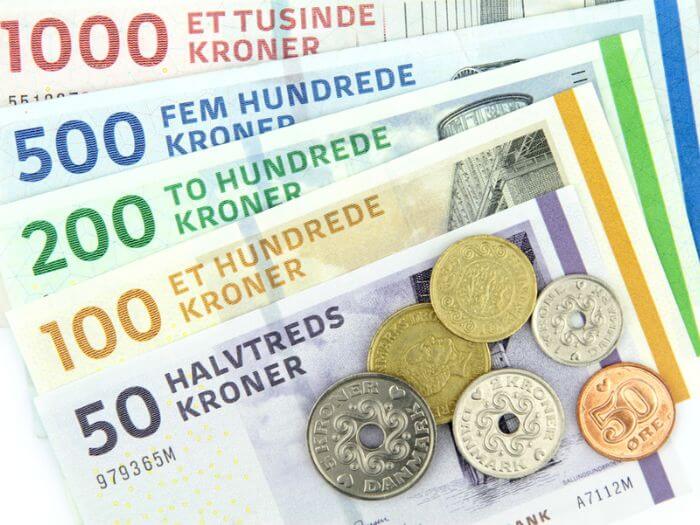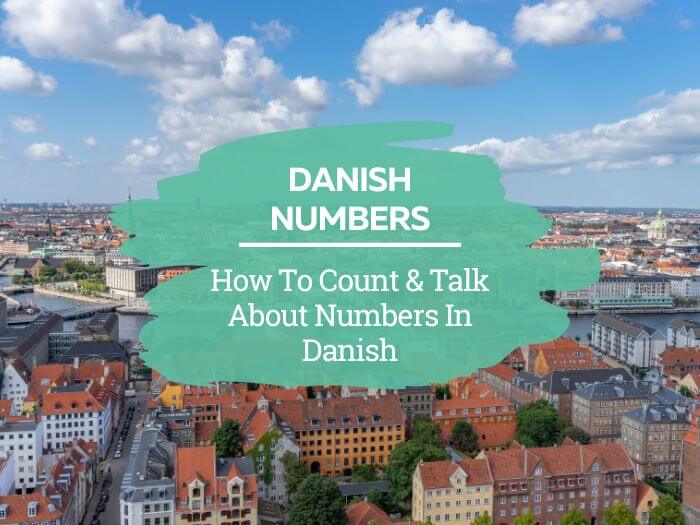If you're learning Danish, there are no two ways about it – you need to learn Danish numbers.
When setting out to learn a new language, the basic numbers are usually one of the first things on the syllabus. And for good reasons.
The good news is, if you know your English numbers, the Danish ones won’t make you feel like you’ve landed on another planet. So let's get you counting in Danish fast!
Pro Tip
By the way, if you want to learn Danish by reading, my top recommendation is Danish Uncovered which teaches you through StoryLearning®.
With Danish Uncovered you’ll use my unique StoryLearning® method to learn Danish through story…not rules. It’s as fun as it is effective. If you’re ready to get started, click here for a 7-day FREE trial.
Table of Contents
Danish Numbers 0 – 10

Knowing the words for numbers from 0 to 10 is not only a very practical ability in itself, it will also help you lots when learning other uses of the numerical system.
So, let’s not waste time before you get to practise the numbers 0 to 10. If you're familiar with English numbers, most of them will surely ring a bell. Remember, we are specimen from the same linguistic apple tree, so it really isn’t that hard.
But here goes:
| 0 | null |
| 1 | en |
| 2 | to |
| 3 | tre |
| 4 | fire |
| 5 | fem |
| 6 | seks |
| 7 | syv |
| 8 | otte |
| 9 | ni |
| 10 | ti |
These are by far the most important cardinal numbers. The best way to get familiar with them is simply to practise. And never worry if your Danish pronunciation isn’t perfect. Because it isn’t, and no-one expects it to be.
Actually, they're pronounced very differently, depending on which Danish dialect you’re listening to.
Thanks to these Danish numbers, you’ll most likely be able to order the right number of drinks in the bar or tickets for the exhibition.
Unless, of course, you are part of a slightly larger group, which brings me to the next set of Danish numbers.
Danish Numbers 11 – 20

So how about we expand the numbers in Danish a bit, to include the special ones between ten and twenty?
Again, they probably won’t sound very outlandish to you:
| 11 | elleve |
| 12 | tolv |
| 13 | tretten |
| 14 | fjorten |
| 15 | femten |
| 16 | seksten |
| 17 | sytten |
| 18 | atten |
| 19 | nitten |
Like in English, 11 and 12 are the odd ones out, as they do not follow the pattern of the ”teen” numbers. The rest simply follow the familiar system of naming the base number (or sometimes a variation of it), and then adding ”teen”/”ten”.
Hopefully, you’ve come this far without too much trouble. With these Danish numbers, you can easily handle most everyday conversations you’re likely to run into.
Danish Numbers: The Tens
However, sooner or later you'll need to expand further, and handle numbers above twenty. You may have heard that the Danish number system is both difficult and vigesimal. Let’s get that cleared from the start: it is neither.
What is true, however, is that some of the tens are formed in a different way that an English speaker is used to.
Let’s have a look:
| 20 | tyve |
| 30 | tredive |
| 40 | fyrre |
| 50 | halvtreds |
| 60 | tres |
| 70 | halvfjerds |
| 80 | firs |
| 90 | halvfems |
| 100 | hundrede |
| 1000 | tusind |
When people speak of Danish numbers being vigesimal, it’s because of the tens from 50 to 90. And their names are indeed based on the number 20.
The thing is, halvfjerds, for example, is a short form of the old Danish halv fire sinds tyve – which translates to ”half three times twenty”, with ”half three” meaning 2 and a half. Likewise, tres simply means ”three times twenty”. Is it starting to make sense?
Anyway, you don’t need to worry too much about it, many Danes are not even aware of it. As long as you know the names of the tens, you’ll be fine.
Danish Numbers: Counting To 1000 And Beyond

With this, you're now able to count to a thousand, and more. Since the Danish number system is, in fact, decimal, you simply add the ones, to the tens.
This way, 22 is toogtyve – ”two and twenty”, and 98 is otteoghalvfems – ”eight and ninety” – just about the reverse of English.
You won’t find anything like e.g. the French quatre-vingt-seize in Danish. It is a decimal numerical system, so no worries!
I’ll mention a few more examples, just to get you going:
- 69 – niogtres
- 418 – firehundredeatten
- 8670 – ottetusindesekshundredehalvfjerds
Should some of this slip your mind in the heat of the moment, you will be understood if you use the simpler forms femti (five ten) for 50, and tretisyv (three ten seven) for 37.
The Swedes, among others, use this system. And it's actually how it is formally written in the financial world.
It’s likely not too often that you will need to go beyond the thousands. But in case you do, here is the quick version, because there actually is a catch, a so-called false friend:
- One million (en million)
- One billion (en milliard [this is the catch])
- One trillion (en billion [catch continues…])
And so, there's a continuous difference in the names of the higher numbers in Danish. But unless you are an advanced astronomer or mathematician, you hardly need to worry about it.
It's not clear how this discrepancy started, but I'm sure scientists have worked out some way to go about it. So, let’s leave the cardinal numbers at that, shall we?
Because there are plenty more things to consider with Danish numbers, like telling the time!
Telling The Time In Danish

The Danes don’t make use of the AM/PM distinction. Where the English clock is kind of reset at noon, the Danish clock simply continues.
This means that 2 o’clock in the afternoon is 14, 7 in the evening is 19, and 11 at night is 23. You'll see these numbers on time tables for trains, busses and on TV programmes.
However, in day-to-day conversation, the 24-hour system is considered rigid and formal. Normally, context will make it obvious what part of the day you’re talking about. So, if you’re invited for dinner at 7, most Danes will say klokken 7.
Also, imagine a text going something like: It was a dark and stormy night, pale moon beams casting eerie shadows on the old village clock. It was 11 :45 PM. Of course not, it was a quarter to midnight!
As for times between whole hours, you will hardly be surprised there either, so long as you remember that halv (half) means half an hour before. Let’s have a look at a few illustrative examples:
| English | Formal Danish | Informal Danish |
| 9:50 AM | 9 :50 | Ti minutter i ti |
| 1:15 PM | 13 :15 | Kvart over et |
| 4:30 PM | 16 :30 | Halv fem |
| 8:17 PM | 20:17 | Sytten minutter over otte |
| 0:40 AM | 00 :07 | Tyve minutter i et |
Once you're comfortable with these, you can combine your way to any time of the day, in both formal and everyday Danish.
Danish also makes use of the broader time indications like morning, afternoon, evening and night. The Danish terms are morgen, eftermiddag, aften and nat, respectively.
Some Danes, though, prefer to reserve the word morgen for the earlier hours of the morning, and use the word formiddag, literally “pre-noon”, for the hours leading up to noon.
Plus, Danes tend to be a bit more rigid, or consistent if you like, when it comes to the evening/night distinction. This means that Fredag nat, Friday night, is the time after midnight, whereas 11 PM on a Friday is still Fredag aften, Friday evening.
The Price Tag And Punctuation In Danish Numbers

The name of the Danish currency is kroner, crowns. One krone can be divided into 100 øre, a word derived from Latin aureus, which roughly translates as “gold coin”. The lowest Danish coin is the 50 øre coin.
However, much to the annoyance of many Danes, you will see many prices tags with numbers that can't be paid for with coins. Signs stating prices like 17,25, or 39,82, and especially 199,95 or 49,95 will meet you everywhere.
These are then, of course, rounded up or down to the nearest half or whole crown, if you pay with cash. If you pay by card, the exact amount, unrounded, will be debited from your account.
But how are they pronounced? Most likely, the person at checkout will say the rounded version, which will make it more readily understandable to the non-Danish speaker.
So when spoken out loud, prices will sound like this in the unrounded and rounded version:
| Price | Unrounded | Rounded |
| 17,75 kr. | Sytten femoghalvfjerds | Atten |
| 59,10 kr. | Nioghalvtreds ti | Ni og halvtreds |
| 99,95 kr. | Nioghalvfems femoghalvfems | Hundrede |
| 420,50 kr. | Firehundredetyve en halv | Firehundredetyve en halv |
| 1342,60 kr. | Trettenhundredetoogfyrre tres | Trettenhundredetoogfyrre en halv |
At a glance, this may look a bit bewildering, I know. But look again, and you will see the system behind the numbers.
Remember this is speech, and some of the Danish numbers are very long. It’s like this in most languages including English; when spelled out, higher numbers can look really overwhelming.
That shouldn’t scare you. The price will appear in numbers on the display at checkout, making it a lot easier for us all.
Another important feature of Danish numbers can be seen in the first of the columns. Namely the use of “,” as opposed to “.”.
In short, commas and points in numbers are used in Denmark, as in most other European countries, exactly opposite of how they are used in the English-speaking world.
So, where the English use a point to separate the whole numbers from decimals, Danes use a comma. And in turn, Danes help the reader through larger numbers with a point, and the English use a comma for this.
The following simple examples should make this clear:
| English | Danish |
| 1,280.05 | 1.280,05 |
| 423,000.95 | 423.000,95 |
| 4,889,112.50 | 4.889.112,50 |
While this may cause a slight confusion the first time you see it, you’ll get used to it in no time. If you continue to get it mixed up, just pretend it’s opposite day!
I Lost My Number, Can I Borrow Yours? Danish Phone Numbers

No, this is not a list of the tackiest pickup lines ever. For a number (sorry!) of reasons, different languages and countries have different traditions for saying your telephone number.
Some divide them into sets of 3 digits, but in Denmark it is customary to divide them into sets of 2 digits. This does not seem unintuitive, as most Danish telephone numbers consist of 8 digits, without the international call code.
This leads us to this way of presenting your number in speech:
| Telephone number | Spoken |
| 29725632 | Niogtyve – tooghalvfjerds – seksoghalvtreds- toogtredive |
| 18190304 | Atten – nitten – nultre – nulfire |
| 25108253 | Femogtyve – ti – femogfirs – treoghalvtreds |
In case your number has an uneven number of digits, I suggest you use the same pattern and the just say the last digit as a single on, like Toogtyve – treogtres – atten – syv.
Danish Ordinal Numbers

You've come a long way on this trip through the Danish number system. So, to wrap things up, let’s have a brief view over the Danish ordinals.
The rule of thumb here is that in Danish, ordinals are written by simply adding a point after the number, so that 23rd is written 23., and this goes all the way from one to billions.
For example, October 17th, would be 17. October. In spoken language, however, things are a bit less simple, at least till you get to 13. At 13 and onwards, simply add the suffix -ende, like you would ”th” in English.
There are a few exceptions to this rule, but the following should meet close to all of your needs:
| English | Danish |
| First | Første |
| Second | Anden |
| Third | Tredje |
| Fourth | Fjerde |
| Fifth | Femte |
| Sixth | Sjette |
| Seventh | Syvende |
| Eighth | Ottende |
| Ninth | Niende |
| Tenth | Tiende |
| Eleventh | Ellevte |
| Twelfth | Tolvte |
| Thirteenth | Trettende |
| Eighty-fourth | Otteogfirsende |
| Hundred and seventy-fifth | Hundredogfemoghalvfjerdsende |
| Thousand and second | Tusindeoganden |
For phonetic reasons, things are a bit different between 30 and 60. In fact, many native Danes are not comfortable with them, and tend to restructure sentences, so as to avoid those particular ordinals. With the above, you really do have all the ones you need.
FAQs About Danish Numbers
What are the numbers 1 to 20 in Danish?
0 – null
1 – en
2 – to
3 – tre
4 – fire
5 – fem
6 – seks
7 – syv
8 – otte
9 – ni
10 – ti
11 – elleve
12 – tolv
13 – tretten
14 – fjorten
15 – femten
16 – seksten
17 – sytten
18 – atten
19 – nitten
20 – tyve
What is the logic behind Danish numbers?
The Danish number system is fairly similar to the English one, and you'll certainly notice some similarities in the Danish numbers 1-20. However, sooner or later you'll need to expand further, and handle numbers above twenty.
You may have heard that the Danish numeric system is both difficult and vigesimal. Let’s get that cleared from the start: it is neither. What is true, however, is that some of the tens are formed in a different way that an English speaker is used to.
When people speak of Danish numbers being vigesimal, it’s because of the tens from 50 to 90. And their names are indeed based on the number 20.
The thing is, halvfjerds, for example, is a short form of the old Danish halv fire sinds tyve – which translates to ”half three times twenty”, with ”half three” meaning 2 and a half. Likewise, tres simply means ”three times twenty”. Is it starting to make sense?
Anyway, you don’t need to worry too much about it, many Danes are not even aware of it. As long as you know the names of the tens, you’ll be fine.
Since the Danish numerical system is, in fact, decimal, to count in Danish you simply add the ones, to the tens.
This way, 22 is toogtyve – ”two and twenty”, and 98 is otteoghalvfems – ”eight and ninety” – just about the reverse of English.
You won’t find anything like e.g. the French quatre-vingt-seize in Danish. It is a decimal numerical system, so no worries!
I’ll mention a few more examples, just to get you going:
69 – niogtres
418 – firehundredeatten
8670 – ottetusindesekshundredehalvfjerds
Should some of this slip your mind in the heat of the moment, you will be understood if you use the simpler forms femti (five ten) for 50, and tretisyv (three ten seven) for 37.
How do they say 90 in Denmark?
In Danish, the number 90 is halvfems.
How do you count 1 to 10 in Danish?
0 – null
1 – en
2 – to
3 – tre
4 – fire
5 – fem
6 – seks
7 – syv
8 – otte
9 – ni
10 – ti
Danish Numbers: Make Them Count!

As always, don’t be afraid to experiment with numbers in Danish, they really aren't that difficult. No-one expects perfection, and using and practising is the fast lane to mastering a new language.
In the meantime, follow the rules of StoryLearning and read books in Danish, especially short stories in Danish.
As you read, you'll come across Danish numbers again and again. And that way, you'll master them in no time!

Olly Richards
Creator of the StoryLearning® Method
Olly Richards is a renowned polyglot and language learning expert with over 15 years of experience teaching millions through his innovative StoryLearning® method. He is the creator of StoryLearning, one of the world's largest language learning blogs with 500,000+ monthly readers.
Olly has authored 30+ language learning books and courses, including the bestselling "Short Stories" series published by Teach Yourself.
When not developing new teaching methods, Richards practices what he preaches—he speaks 8 languages fluently and continues learning new ones through his own methodology.










































